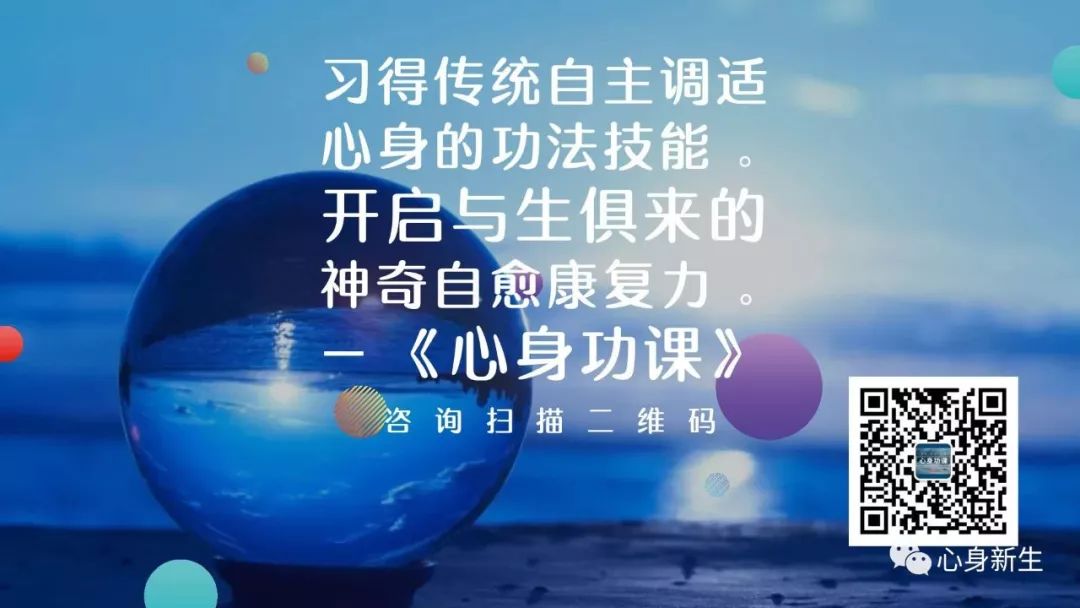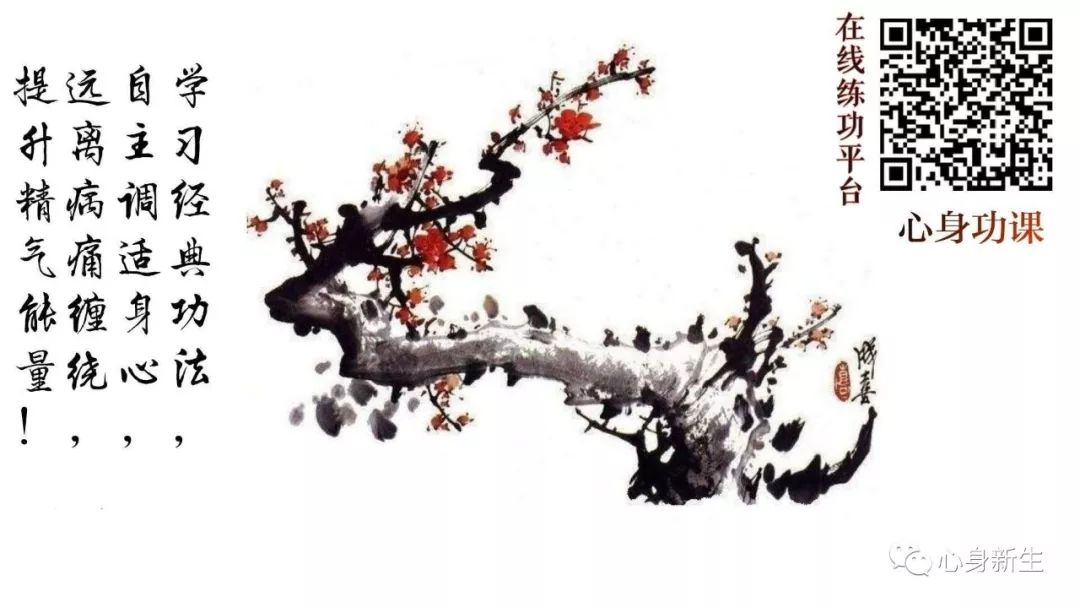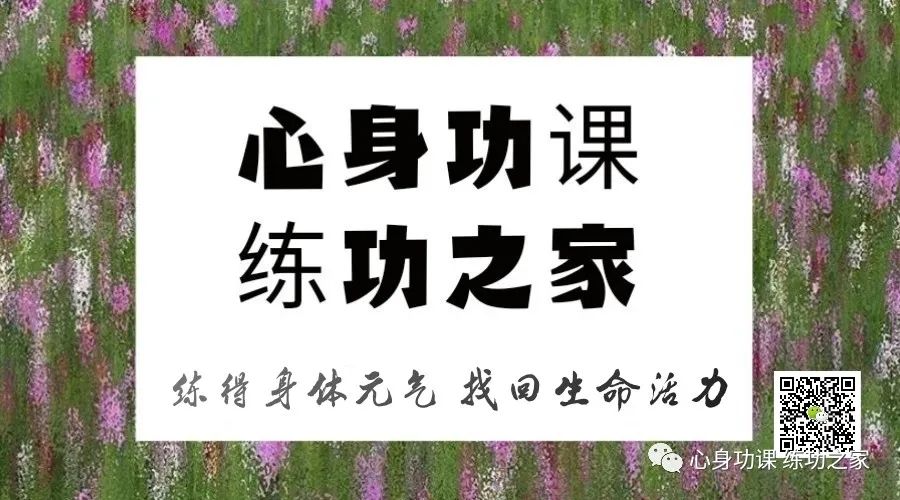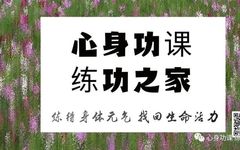Heart and Body Practice·Health Cultivation for Body and Mind ▲
(Click to join “Heart and Body Renewal”)
Daoyin is a traditional health preservation and therapeutic method that achieves the alignment of bones and flexibility of tendons through the active regulation and exercise of body, mind, and breath. The history of Daoyin in health preservation and treatment is very long, and its content is quite rich. Even today, Daoyin is widely used in various clinical departments[1]. Daoyin emphasizes the practice of both internal and external aspects, with a focus on the internal. Its content includes movement guidance, breath guidance, and intention guidance, among which movement guidance is the most common[2]. The currently popular routines such as Baduanjin (Eight Pieces of Brocade), Yijinjing (Muscle-Tendon Change Classic), and Wuqinxi (Five Animal Frolics) have established movement patterns, but they can easily lead people to focus on external forms and lose the original meaning and internal basis of Daoyin, resulting in difficulties in its development and application. This article aims to explore the basic components of Daoyin—”movement” and its internal basis—”essence and qi,” to return to the original meaning and connotation of Daoyin.
1. “Movement” is the Manifestation of VitalityIn the opening chapter of the “Huangdi Neijing” (Yellow Emperor’s Inner Canon), “Suwen: On the Ancient Heavenly Truth,” it is recorded: “In ancient times, people lived to a hundred years in both spring and autumn, and their movements did not decline; today, people at fifty years old have declining movements. Is it the difference in times, or will people lose it?” “Movement” can be used to judge a person’s health and longevity; “movement” is the manifestation of life vitality, and “non-declining movement” is an indicator of health and longevity.In ancient texts, “movement” is a synonymous compound word. In the “Shuowen Jiezi,” it states, “Movement is action”; the “Yijing” (Book of Changes) points out, “Movement is vigorous.” The “Shuowen” explains, “Action is to rise”; the “Erya” explains, “Action is to create and to be.” Movement is activity and creation; it is the result of physiological activities in natural life and also reflects the cyclical and eternal nature of life. In the “Laozi: Chapter 16,” it is recorded, “Attain utmost emptiness, maintain steadfast tranquility; all things simultaneously act, I observe their return.” Natural life continuously engages in activity and creation in a state of emptiness and tranquility, thus showcasing its life journey.2. The Connotation of “Movement” is Essence and Qi“Ancient people” and “modern people” differ in lifespan and movement states; Huangdi believes the possible reason is “the difference in times, or will people lose it?” Clearly, ancient times and modern times are different, so what exactly will modern people “lose”? Qibo replied: “Ancient people, those who understood the way, followed the principles of yin and yang, harmonized with the techniques, had moderation in food and drink, maintained regularity in daily activities, did not engage in excessive labor, thus could preserve their form and spirit, and complete their lifespan, living to a hundred years before departing.” In ancient times, people had a way of health preservation, emulating the laws of heaven and earth’s yin and yang, using techniques to harmonize body and mind, and moderating their diet, daily activities, and labor, thus preserving their form and spirit, achieving health and longevity, living to a hundred years.Qibo further stated: “Modern people are not like this; they use wine as a beverage, treat indulgence as normal, drunkenly enter rooms, exhaust their essence, dissipate their true nature, do not know how to maintain fullness, do not timely guard their spirit, seek to satisfy their hearts, go against the natural way of life, and have irregular daily activities, thus decline by fifty years.” In modern times, people excessively drink, engage in prolonged labor, and coupled with post-drinking activities and irregular daily routines, lead to the depletion of essence and qi (true qi), unable to recover in time, not understanding the principle of internal spirit preservation, solely seeking external pleasures, violating the natural way of life, resulting in premature aging.The greatest difference between “ancient people” and “modern people” lies in the former preserving essence and qi, while the latter depleting it. Essence and qi are the core of health preservation; if essence and qi are cultivated properly, one achieves health and longevity; if essence and qi are dissipated recklessly, one faces premature death. Among them, before birth, the essence and blood of parents condense into a fertilized egg, known as congenital essence; after birth, the five grains and various flavors provide nutrition and energy, transforming into acquired essence. Essence is stored in the five zang and six fu organs, performing various physiological functions; congenital essence is mainly stored in the kidneys, governing growth and development. Essence nourishes the body through the meridian system.The physiological functions such as hearing, sight, speech, and movement are essentially the results of the operation of essence; when essence is sufficient, the senses are sharp, tendons are strong, the zang and fu are harmonious, and the body is robust. When essence is insufficient, the head tilts, vision deepens, tendons and bones weaken, the zang and fu are fragile, making one prone to illness and difficult to recover. Among them, kidney qi (kidney stores essence) is an important source of movement; the “Suwen: Linglan Miji Lun” mentions, “The kidney is the official of strength, from which skills emerge.” The essence in the kidneys is an important guarantee for non-declining movement. The “Suwen: On the Ancient Heavenly Truth” states, “Why do those who are old still have children?” “It is because their heavenly lifespan exceeds, their qi and meridians are always open, and their kidney qi is sufficient.” It can be seen that kidney essence is also a guarantee for longevity and reproduction; additionally, the constant flow of qi and the regulated circulation of essence are also important guarantees for health and longevity.3. The Health Preservation and Treatment Technique of “Movement”—DaoyinFrench philosopher Voltaire said, “Life is movement.” From the perspective of traditional Chinese medicine and health preservation, movement and action also have different meanings; movement refers to the internal qi movement of life, while action refers to the external physical movement of life. The traditional health preservation and treatment movement is Daoyin. Daoyin is to guide externally and draw internally; it promotes the internal movement of qi through the activity of external limbs and trunk. Daoyin is a proactive self-exercise of body and mind, with diverse forms and simple methods.In the “Baopuzi: Separate Intentions” written by Ge Hong in the Jin Dynasty, it states: “Daoyin does not rely on naming symbols or painting representations, but is nameless and formless. Whether bending and stretching, walking or lying down, leaning or standing, pacing or breathing, all are Daoyin.”Daoyin has a very long history. It originated in the ancient times mentioned in the “On the Ancient Heavenly Truth.” According to the “Lüshi Chunqiu: Ancient Music,” it is recorded that “In the beginning of the Taotang clan, the yin was often stagnant and accumulated, the waterways were blocked and did not flow, the people’s qi was stagnant and blocked, and their tendons and bones were tight and unresponsive, thus they created dance to guide the qi and open the tendons and bones.” In ancient times, there were severe weather conditions with floods and accumulated yin, causing many people to suffer from qi stagnation and tight tendons and bones, so the ancients invented “dance” to “guide” the qi and facilitate the tendons and bones. This dance, which has the effect of dispelling diseases and recovering health, is the source of Daoyin techniques.The term “Daoyin” was first recorded in the “Zhuangzi: Ke Yi” chapter: “Blowing and breathing, exhaling the old and inhaling the new, bears stretch and birds extend, this is what the practitioners of Daoyin, those who cultivate the body, and those who seek longevity like Pengzu, enjoy.” Daoyin includes breath regulation, limb stretching, and has the effect of cultivating the body and extending life. In the “Huangdi Neijing,” Daoyin is listed as one of the five major conventional therapies. The “Suwen: On Different Methods and Appropriate Formulas” records: “In the eastern region… its treatment should be with stone needles;” “In the western region… its treatment should be with toxic drugs;” “In the northern region… its treatment should be with moxibustion;” “In the southern region… its treatment should be with fine needles;” “In the central region… its treatment should be with Daoyin and pressing.” The central area, with flat land, abundant water, and rich products; the local people have a variety of foods and do not need to labor too much, thus they are prone to diseases such as weakness, reversal, cold, and heat; these diseases are suitable for treatment with Daoyin and pressing methods.As a safe, simple, and effective method for health preservation and disease dispelling, Daoyin was quite popular among the upper classes in ancient China. For example, the precious artifact from the Warring States period—”Xingqi Yupei Ming” records a complete process of Daoyin: “Moving qi, deep then storing, storing then stretching, stretching then descending, descending then settling. Settling then solidifying, solidifying then sprouting, sprouting then growing, growing then retreating, retreating then returning. Heaven is above, earth is below. Following is life, going against is death.” This artifact is a hollow twelve-faced object, each face has three inscriptions. Some researchers speculate that this artifact was the handle of a staff used by a powerful person at that time. The inscriptions on the staff’s handle indicate that the practice of Daoyin and qi movement was an important part of the life of the staff owner.During the Wei, Jin, and Northern and Southern Dynasties, Daoyin was also widely popular among the scholar-official class. According to records in the “Records of the Three Kingdoms” and others, during the Cao Wei period, Cao Cao and his sons recruited Daoyin practitioners, such as Gan Shi and Huangfu Long, to teach the techniques of “Chishi Langgu, breathing and exhaling” to the public. The famous calligrapher Wang Xizhi of the Jin Dynasty once exchanged the “Huangting Jing” (Outer Scene) with a Taoist from Shanyin for a group of geese. Wang then created the “Goose Foot Play” based on the swimming movements of the geese. The famous physician, Tao Hongjing, of the Jin Dynasty believed that Daoyin “treats diseases before they occur, harmonizes unbalanced qi,” and is “the great law of health preservation, the mysterious technique of dispelling diseases” (from “Baopuzi: Inner Chapters: Separate Intentions”).In the Sui and Tang Dynasties, Daoyin was still part of the official medical system, with a massage department established in the Taiyi Office, using Daoyin and pressing to treat diseases. The Sui Dynasty’s Taiyi Ling, Chao Yuanfang, compiled 289 methods of “Health Preservation Daoyin” in the “Treatise on the Sources and Symptoms of Various Diseases,” removing 76 repeated ones, totaling 213 Daoyin methods for treating 110 disease patterns. The famous physician of the Tang Dynasty, Sun Simiao, also strongly advocated Daoyin, recording the “Tianzhu Country Massage Method” and “Laozi Massage Method” from India and Taoism in his work “Qianjin Yaofang.” Sun Simiao believed that Daoyin “harmonizes essence, promotes blood circulation, prevents wind and qi from entering, and those who practice it do not fall ill.”It can be said that throughout history, many renowned TCM practitioners have strongly advocated this proactive medical exercise for health preservation. In addition to the famous physicians mentioned above, Zhang Zhongjing, known as the “Sage of Medicine” in the Eastern Han Dynasty, advocated in the “Shanghan Zabing Lun” that “If the limbs feel stagnant and heavy, then practice Daoyin, breathing, acupuncture, and ointment, do not let the nine orifices be blocked”; the famous physician of the Northern and Southern Dynasties, Tao Hongjing, created the classic Daoyin “Six Character Formula”: “Inhale with one, exhale with six. Inhale one means to breathe in; exhale six means to blow, call, sigh, exhale, puff, and hiss, all are exhalations… to treat diseases. Blowing dispels heat, calling dispels wind, sighing dispels annoyance, exhaling lowers qi, puffing disperses cold, hissing relieves extremes.” The outstanding physician of the Ming Dynasty, Li Shizhen, actively advocated Daoyin exercises and practiced them himself, proposing the famous saying, “The inner landscape tunnel can only be illuminated by those who look back.” The Ming Dynasty physician, Li Ting, believed that “The great method of Daoyin is set for the deficiency of qi and blood” (from “Introduction to Medicine”). The Qing Dynasty physician, Shen Jinao, pointed out that “Daoyin and movement are the key techniques for health preservation, but to achieve longevity, one must first dispel diseases; all that is guided and moved belongs to the methods of dispelling diseases” (from “Sources and Streams of Various Diseases”).4. The Biochemical Distribution of Daoyin Movements and EssenceEssence and qi are the basic components of life and the source of vitality. The five zang store essence and qi without leaking; the qi of the meridians is true qi (i.e., essence). The essence in the five zang needs to be abundant; the essence in the meridians needs to be unobstructed[3]. Human movement is the external manifestation of internal essence operation; one can also regulate their physiological activities through external limb movements, breathing, and mental activities. On one hand, Daoyin helps promote the circulation of qi and blood, the distribution of essence, to eliminate stagnation, open the meridians, and prevent problems; on the other hand, Daoyin also aids in the biochemical transformation of essence, nourishing the five zang, strengthening the body, and extending life.(1) Daoyin Aids in the Biochemical Transformation of EssenceAfter birth, the sources of essence include the congenital essence stored in the kidneys and the acquired essence produced by the spleen and stomach’s transformation of food. The congenital essence in the kidneys comes from heaven and earth and parents, easily depleted and difficult to nourish. The “Huangdi Neijing” states, “When a person is born, the essence is first formed, and when the essence is formed, the brain and marrow are formed,” and also states, “The essence of life is called essence, and the mingling of the two essences is called spirit.” Congenital essence transforms into brain and marrow, producing spirit; congenital essence operates in the Ren and Du meridians, stored in the kidneys[4]; congenital essence can produce heavenly gui, governing male sperm production and female ovulation, thus achieving “yin and yang harmonize, hence children can be born,” but this process for men does not exceed eighty-eight, and for women does not exceed seventy-seven; congenital essence determines a person’s lifespan. If due to staying up late, excessive sexual activity, or reckless actions, the congenital essence is depleted too quickly, it will shorten lifespan; conversely, if one preserves congenital essence properly, they can achieve longevity, even “living beyond heaven and earth, with no end time.”Daoyin is an ancient technique that has the content of regulating and transforming the congenital essence in the kidneys. The “Laozi Xiang Er Zhu” by Li Daoling in the Han Dynasty states: “The body is a vehicle of essence, and essence should be carried by it.” The method of “carrying it” has many contents in various Daoyin techniques in Taoism, specifically manifested as “opening the small heavenly circuit.” For example, in the ancient Taoist health preservation techniques, there are many such contents, stimulating the reproductive system gently to activate the transformation of life essence (practicing form to generate essence), while coordinating breathing and intention to achieve the circulation of essence in the Ren and Du meridians (returning essence to nourish the brain), thus extending the life cycle[5-6]. The longevity effects of Daoyin are incomparable to current general fitness exercises.Daoyin also aids the spleen and stomach in transforming essence. The spleen governs the limbs and muscles; the activity of the limbs and muscles also helps the spleen and stomach’s transformation. The famous physician Hua Tuo during the Three Kingdoms period proposed when creating the Five Animal Frolics, “When moving and shaking, the qi of grains is consumed, blood vessels circulate, and diseases do not arise.” The qi of grains is the essence of food and drink, which needs to be further transformed into essence (yuanqi) in the body to truly exert its nourishing effect; otherwise, it will stagnate in the body, leading to obesity and metabolic disorders. The Han Dynasty philosopher Yang Quan in the “Physical Principles” stated: “Yuanqi surpasses grain qi; such a person is thin and lives long; grain qi surpasses yuanqi; such a person is fat and does not live long. The art of nurturing life often keeps grain qi low, thus diseases do not arise.”The classic Daoyin for strengthening the spleen and stomach is “walking after meals.” The famous “King of Medicine” Sun Simiao lived to 141 years old; he said: “On ordinary days, after snacks and meals, go out and walk fifty to sixty steps, after meals, walk one to two hundred steps, walk slowly, do not let the qi be hurried.” He then said: “After eating, walking slowly leads to longevity.” The health enthusiast Su Dongpo of the Tang Dynasty also proposed: “Eat only when hungry, stop before full, and stroll leisurely to ensure the abdomen is empty.”(2) Daoyin Aids in the Distribution of EssenceThe earliest clear concept of nourishing life through physical movement is found in the “Lüshi Chunqiu,” which states, “When the spirit is at peace with the body, longevity is achieved”; “If the body does not move, essence does not flow; if essence does not flow, qi stagnates.” In the view of life in traditional Chinese medicine, the body is the abode of essence, and essence is the driving force of life. Movement Daoyin is to regulate essence through physical movement, thus achieving harmony between form and essence (spirit), which can truly realize longevity. The “Huangdi Neijing” states: “The body and spirit are together, and one completes their lifespan.”The aforementioned Hua Tuo, based on the principle of “flowing water does not rot, and the door hinge does not get worm-eaten,” combined with the animal movements mentioned in the “Huainanzi,” created a set of bionic Daoyin—Five Animal Frolics. “The Five Animal Frolics, one is the tiger, two is the deer, three is the bear, four is the monkey, five is the bird,” can “eliminate diseases, benefit the limbs, and serve as Daoyin. If the body feels uncomfortable, perform one of the animal frolics, feel joyful and sweat, then apply powder, and the body will feel light and desire food.” Hua Tuo’s two disciples, Wu Pu and A-Dang, practiced diligently; one was ninety years old with sharp senses, and the other, though old, could turn white hair black and regrow teeth, demonstrating the health preservation and longevity effects.Regarding the theoretical basis of Daoyin, the detailed description can be attributed to the “Fuqijing Yiyi Lun: Daoyin Lun”: “The joints of the limbs are fundamentally for movement; the meridians and vessels are for circulation. Now that one is idle, there is no movement, it is necessary to practice Daoyin to achieve harmony and smoothness, the door hinge does not creak, its meaning is indeed true.” “The blood, qi, and spirit of a person are what sustain life and circulate their essence; the meridians are what transport blood and qi… thus it is known that the five labors cause damage, and movement and stillness are the causes; the five animals guide and shake their joints. The human body, with its upper and lower connections, has a source and flow of qi, ascending and descending in order; the methods of Daoyin indeed have their purpose.”In another Daoyin book, “Xuanjian Daoyin Method,” it also quotes Laozi’s words: “Between heaven and earth, it is like a bag, empty yet unyielding, moving yet producing more,” believing that “When people practice Daoyin and shake, their spirit increases. Daoyin externally heals, while internally, it is like moxibustion attacking the source of the nourishing points, thus all ailments are eliminated at the flow’s end.” Jin Dynasty’s Ge Hong stated: “Daoyin treats diseases before they occur, harmonizes unbalanced qi. Moving it allows the hundred joints to be unblocked; if blocked, the three officials’ blood coagulates. It is indeed the great law of health preservation, the mysterious technique of dispelling diseases.”5. ConclusionIn summary, the original meaning and connotation of Daoyin is to regulate the internal essence of life through bodily movements, including the use of breath and intention, to promote its distribution and biochemical transformation, thus maintaining the health and vitality of the body. Daoyin is one of the five traditional therapies; modern people’s lifestyles are very similar to what is mentioned in the “Huangdi Neijing” regarding “people eat mixed foods and labor little,” leading to diseases such as weakness, reversal, cold, and heat. Therefore, widely conducting research and clinical practice on Daoyin, deeply exploring this green and effective method of TCM for health preservation and treatment, is an organic part of promoting traditional Chinese medicine and serving the health strategy.
– END –




